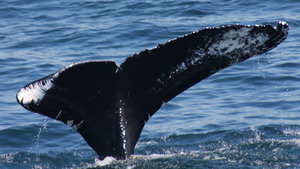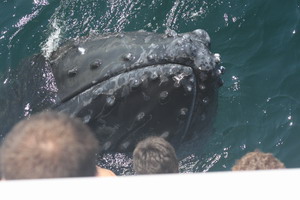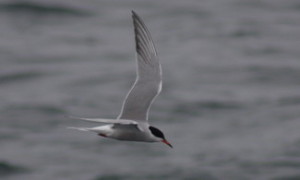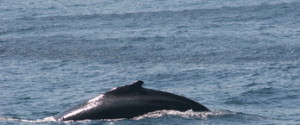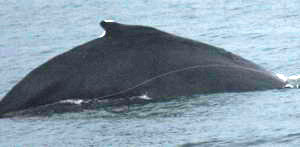Dolphin Fleet Naturalist Notebook 21 June to 27 June
21 June was bright and sunny and we began the day by steaming north toward the southeast corner of Stellwagen Bank. With Truro’s Highland Light still in view, we had our first sighting of Terrace, a female humpback, and her calf. Terrace’s left fluke is heavily damaged and scarred, most likely due to an encounter with a boat propeller. Unfortunately, these types of scars and markings are not uncommon among these large whales who share their environment with humans.
Terrace
Although there are many problems with dense boat traffic in these waters, these humpbacks are frequently curious about vessels moving in and out of their environment, and occasionally treat Dolphin Fleet passengers to what we call a “close boat approach.” Today, one of our humpbacks came so close to the boat that we got a close-up look at its knobby head. Humpback whales have grapefruit-sized lumps all over their heads which are actually individual hair follicles. Having hair at some point is, after all, one of the defining characteristics of a mammal. It’s likely that these bristly hairs can be used as sensory organs to learn more about the whale’s surroundings, whether they be currents or the movements of prey. In the photo below, see if you can see these large protrusions, also known as “tubercles.”
On June 22 we once again headed east at Race Point and entered into what is sometimes known as “Finback Alley,” between Race Point in Provincetown and Highland Light in Truro. Not surprisingly, we began our trip with an attempt to track the elusive fin whale. While fin whales are one of our most common sightings, they are not for the impatient whale watcher. They are frequently elusive, and very fast. Furthermore, their tendency to swim in circles as they feed makes it very hard to predict where they will come up next.
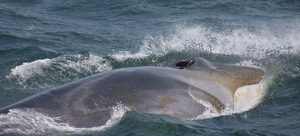
When they do surface, however, it is truly a spectacular sight. As they burst through schools of fish, they will frequently roll to the side, generating a wall of whitewater and giving us a brief glimpse of their tail. As they lunge at the surface we try to photograph the unique pattern on their right side, which is known as the blaze and chevron.
One of the first things that first-time whale watchers want to know is “how long will it take us to find whales?” Veteran whale watchers know that there is no good answer to that question! It’s not unheard of to find a whale in Provincetown Harbor, whereas other days it can take several hours! The morning of June 23rd was one of these days where patience and observational skills were key. After scanning the seas for almost an hour and fifteen minutes, we finally found a mother and calf humpback pair in the center of Stellwagen Bank who seemed to be hightailing it towards the southeast corner of the bank. Captain Scott clocked their speed at almost 6 knots!
Over the course of the trip, we encountered three more humpbacks, all of whom seemed to be bound for the same destination. As a result, we knew just where to go for our afternoon trip.
When we returned, conditions had changed, and we could see that the water was thick with sand lance. Huge schools of bait made the water shimmer and pulse, and as terns, shearwaters and gulls flew over these schools, scoping out their next meal, the small fish would leap out of the water, causing a wave effect underneath the birds’ flight patterns.
Sand eels at the surface
This glut of food had not escaped our humpbacks, and we found ourselves amazed at their unusual feeding style. The sand eels–their favorite food items–were so close to the surface that the whales would lunge upwards, snapping their jaws audibly as they captured each mouthful of fish. As they rapidly burst forth from the water, we could see their engorged throats, filled to the brim with miniscule bait fish.
June 24th was flat and calm, and our naturalists noted that one could smell the plankton wafting on the breeze. Some people think that plankton smells like melon, others insist that it smells like popcorn! In any case, it is very distinct. Frequently, this plankton scent is particularly detectable along upwellings. Upwellings happen when a current hits an underwater feature like a ledge. When this happens, phytoplankton and nutrients get pushed up to the surface where they phytoplankton can get sunlight and photosynthesize. This sets off a chain reaction of food web productivity as animal plankton feeds on the phytoplankton and circulating detritus, fish and and certain birds feed on the animal plankton, and many other animals gather to feed on the fish. An upwelling can be detected sometimes by looking for a surface disturbance, often surrounded by diving birds like the common tern.
Like birds, whales often can be found along upwellings, for the same reason. Today, we had a mother and calf humpback whale basking near the southern edge of the bank. For almost twenty minutes this calf rolled around right off the stern of the Dolphin VII. The calf even lifted its head up to get a closer look at the boat–a spyhop! Our naturalist noted that the mother humpback is particularly enormous. She certainly needs to be to have given birth to that one ton calf this previous winter!
June 25th was another big feeding day for our humpbacks. In the afternoon, our naturalist noted that the whales were moving very fast. Soon, their destination was clear. Looking out over the water, we could see brown, ribbon-like creatures squirming at the surface–a school of sand lance. Soon afterward, kicks and lunges abounded as these animals feasted on this huge quantity of bait fish.
Humpback with school of sand lance
The feeding continued into the evening and Mark, our Dolphin VIII naturalist remarked that there was “unbelievably fantastic wide open mouth lunge feeding!” Broomball, one of our newly-named humpacks, was especially voracious. In the photo below she is pictured lunging through a school of fish.
On this trip, groups of 4-6 humpbacks, including Bisou, Pipette, Coral, Anchor and Joust, continued to feed by kickfeeding, lunging, and blowing circular rings of bubbles. In the photo below, note the baleen hanging down from the whale’s upper jaw. When this humpback closes its mouth, the bristly filaments will trap the fish, now in the resevoir of its lower jaw, while allowing the seawater to drain out.
On June 26th the feeding had subsided for the most part, but there were still ample animals, particularly northeast of Race Point and east of Stellwagen Bank. Three species of baleen whales– humpbacks,
fin whales, and Minke whales–were seen today. In the morning, we came across a trio of fin whales, which even included a calf! Gulls, shearwaters and terns circled overhead as the adult fin whales lunged through schools of fish at the surface.
In the afternoon, while headed towards spouts on the horizon, we saw something unusual bobbing at the surface. Upon closer examination, we realized that it was the large, triangular dorsal fin of a basking shark. Basking sharks, despite being one of the largest fish on the planet, feed on plankton, filtering out flea-sized crustaceons using a feeding style not-unlike that of the North Atlantic right whale, another plankton eater. As we slowly approached this shark, we could see that its mouth was wide open. A school of sand lance could also be seen at the surface. Presumably, the shark and the sand lance were feeding on the same small creatures.
On June 27th, passengers on the Dolphin VI and the Dolphin VIII had the unique opportunity to learn about whale entanglements first hand. These whale watch boats were asked by the Provincetown Center for Coastal Studies large whale disentanglement team to stand by as they tried to locate a humpback whale named Ebony, who was observed with rope coming out of her mouth.
Entanglements are not always easy to see. Furthermore, Ebony was travelling with a large group of similar-looking humpbacks, so it was important to have as many eyes as possible keeping track of this whale until the disentanglement team arrived from Provincetown. When the R/V Ibis, a boat equipped for large whale disentanglement, arrived on the scene, they attempted to throw a grapple to put pressure on the rope. Unfortunately, weather conditions worsened and they had to return to shore before human safety became an issue.
Whale rescue and disentanglement is a complex process and often requires multiple attempts. However, photographic documentation is also critical to the process and these rescuers were able to obtain valuable information about Ebony’s entanglement so that if she is seen again, they will have a detailed plan in place as to how to attempt disentanglement in the safest, most efficient way. For more information on whale disentanglement, please visit www.coastalstudies.org






